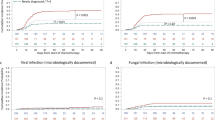Abstract
A retrospective analysis was performed on 100 patients with non-Hodgkin’s lymphoma (NHL, n = 75) or Hodgkin’s disease (HD, n = 25) who underwent peripheral blood progenitor cell transplant (PBPCT) following high-dose chemotherapy (HDCT) with BCNU, etoposide, cytarabine and melphalan (BEAM) between March 1994 and June 1997. Following PBPCT and until engraftment all patients received oral ciprofloxacin and fluconazole, patients with positive Herpes simplex virus serology received acyclovir and 91 patients received filgrastim. The median days of neutropenia and days to an absolute neutrophil count (ANC) >500/mm3 were 6 and 9, respectively. Febrile neutropenia occurred in 68 patients. Gram-positive bacteremia occurred in 14 patients. No gram-negative infections, invasive fungal infections, intensive care visits or deaths occurred during the period of neutropenia or in the first 30 days following transplant. In multivariate logistic regression the risk of development of any infection was associated only with the duration of neutropenia (P = 0.02) and the risk of bacteremia was associated only with the number of CD34+ cells infused (P = 0.046). Among 49 patients treated in the outpatient setting, 14 (28%) were never admitted. High-dose chemotherapy with BEAM supported by PBPCT, prophylactic antibiotics and filgrastim resulted in a low incidence of infections and no acute mortality. WBC engraftment occurred rapidly allowing for a predictable course during which lengthy hospital stays and amphotericin therapy could be avoided.
This is a preview of subscription content, access via your institution
Access options
Subscribe to this journal
Receive 12 print issues and online access
$259.00 per year
only $21.58 per issue
Buy this article
- Purchase on Springer Link
- Instant access to full article PDF
Prices may be subject to local taxes which are calculated during checkout
Similar content being viewed by others
Author information
Authors and Affiliations
Rights and permissions
About this article
Cite this article
Seropian, S., Nadkarni, R., Jillella, A. et al. Neutropenic infections in 100 patients with non-Hodgkin’s lymphoma or Hodgkin’s disease treated with high-dose BEAM chemotherapy and peripheral blood progenitor cell transplant: out-patient treatment is a viable option. Bone Marrow Transplant 23, 599–605 (1999). https://doi.org/10.1038/sj.bmt.1701610
Received:
Accepted:
Published:
Issue Date:
DOI: https://doi.org/10.1038/sj.bmt.1701610
Keywords
This article is cited by
-
High-dose chemotherapy and autologous stem-cell transplantation in Korean patients with relapsed or refractory Hodgkin lymphoma
International Journal of Hematology (2013)
-
Autologous hematopoietic stem cell transplants that utilize total body irradiation can safely be carried out entirely on an outpatient basis
Bone Marrow Transplantation (2006)
-
Lack of caregivers limits use of outpatient hematopoietic stem cell transplant program
Bone Marrow Transplantation (2002)
-
Infectious complications in breast cancer patients undergoing peripheral blood stem cell transplantation: a single center retrospective analysis towards outpatient strategy
Bone Marrow Transplantation (2001)



